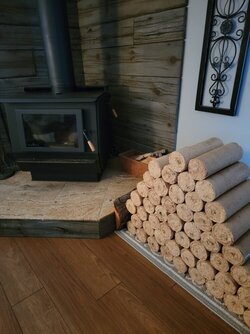Checking in a week later, I didn't have much time to look at the top of the chimney during daylight until the weekend.
There is definitely a marked initial improvement with the bypass fully latched, within a minute I can see the difference between the smoke plume with the bypass engaged and with the catalyst engaged, where before it seemed like a more gradual reduction. That being said, on startup and reloads, it still feels like the cat is getting overwhelmed by smoke output from the firebox. I tested with both white pine and red oak, and the pine is 'worse', but for both there is still an easily noticeable smoke plume for a good hour or even a bit more after initially engaging the cat. Leaving the thermostat at or near full for the first 30 minutes makes for greater smoke volume until it gets turned down. Quickly turning the thermostat down to a temp that will stabilize the cat thermometer around 2 o'clock after a reload still has an easily noticeable plume, though less smoke than if I left it full blast and the cat thermometer was at 4 o'clock.
A few operation questions:
The manual suggests leaving the thermostat at wide open for 20-30 minutes after engaging the cat. Is this primarily to ensure the fire gets well established to make sure you don't stall out the fire/cat, or because it is necessary for some less obvious reason? On a cold start or reload when the cat is inactive and I really load up with pine, I've sometimes been turning down the tstat a bit before the cat gets into the active zone because my flue gas temps are getting close to unsafe levels before I can get the cat engaged. When I've left the tstat around 4-5o'clock my flue gases have stayed much safer while the cat works its way to active, and if I leave the tstat there when I engage the Cat, the fire and cat don't have any noticeable issues burning and rising up to the higher side of the operating range. 30 minutes on high also really cuts into burn times for me.
I'm seeing flue gas temps in the stove pipe range from 450 when my cat thermometer is reading 85-90% to around 300 when the cat is at around 50%. is this good/appropriate? I've seen commentary on these forums that you want to be aiming for 400 flue gas temps to avoid creosote build-up in the chimney, and I wasn't sure if that was a universal guideline, or if things were different between a cat and tube-style stove.
I've had a pretty frustrating experience burning wood this winter so far. Some of it my own fault (not fully engaging the bypass lever), and some of it from a bad chimney liner install, and after having a chimney fire, and I'm trying to make sure I'm minimizing my creosote accumulation as much as possible.




